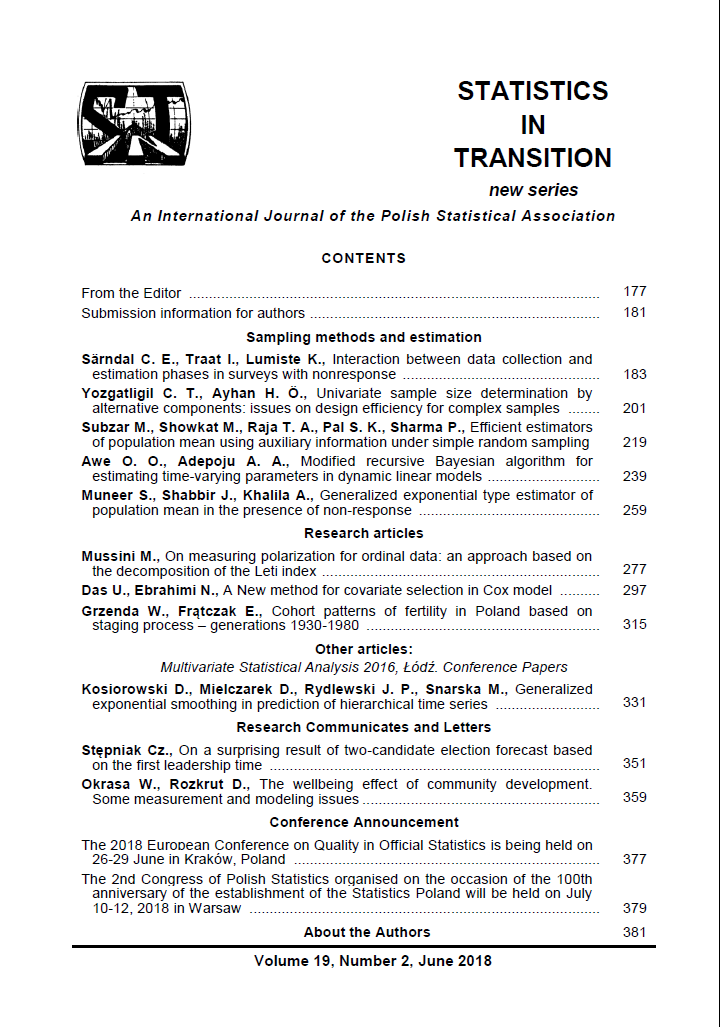ARTICLE
ABSTRACT
Sample size determination for any sample survey can be based on the desired objectives of the survey as well as the level of confidence of the desired estimates for some survey variables, the desired precision of the survey results and the size of the population. In addition to these, the cost of enumeration can also be considered as an important criterion for sample size determination. Recently, some international organizations have been using univariate sample size determination approaches for their multivariate sample designs. These approaches also included some design efficiency and error statistics for the determination of the univariate sample sizes. These should be used for determining the survey quality measures after the data collection, not before. The additional components of the classical sample size measure will create selection and representation bias of survey estimates, which is discussed in this article.
KEYWORDS
univariate sample size, representation bias, sample allocation, error statistics, design efficiency measures.
REFERENCES
ADCOCK, C. J., (1997). Sample Size Determination: A Review. The Statistician,46 (2), pp. 261–283.
ALIAGA, A., REN, R., (2006). Optimal Sample Sizes for Two-Stage Cluster Sampling in Demographic and Health Surveys. DHS Working Papers, No. 30, Demographic and Health Research, ORC Macro.
ALKAYA, A., AYHAN, H. Ö., ESIN, A., (2017). Sequential Data Weighting Procedures for Combined Ratio Estimators in Complex Sample Surveys,Statistics in Transition, 18 (2), pp. 139–162.
AYHAN, H. Ö., (1981). Sources of Nonresponse and Nonresponse Bias in 1978 Turkish Fertility Survey. Turkish Journal of Population Studies, 2-3, pp. 104–148.
AYHAN, H. Ö., (1991). Post-stratification and weighting in sample surveys. Research Symposium ‘91, State Institute of Statistics, Ankara. pp. 1–11.
AYHAN, H. Ö., HANCIOGLU, A., TÜRKYILMAZ A. S., ÜNALAN, T., (2000). Sample Design, Implementation and Outcome. Chapter 13 in Push and Pull Factors of International Migration: Country Report – Turkey (H. Ö. Ayhan, et. al., eds). EUROSTAT Working Papers; Population and Social Conditions 3/2000/E/n0 8, Luxembourg: EUROSTAT Press, pp. 112–131.
AYHAN, H. Ö., (2003). Combined Weighting Procedures for Post-Survey Adjustment in Complex Sample Surveys. Bulletin of the International Statistical Institute 60, pp. 53–54.
AYHAN, H. Ö., ISLAM, M. Q., (2005). Sample Design and Allocation for Random Digit Dialling, Quality and Quantity, 39 (5), pp. 625 – 641.
BRICK, J. M., (2013). Unit Nonresponse and Weighting Adjustments: A Critical Review, Journal of Official Statistics, 29 (3), pp. 329–353.
DELL R. B., HALLERAN, S., RAMAKRISNAN, R., (2002). Sample Size Determination, ILAR J, 43 (4), pp. 207–213.
DESU, M. M., RAGHAVARAO, D., (1990). Sample Size Methodology, Boston: Academic Press.
DHS, (2012). Demographic and Health Surveys Methodology, Sampling and Household Listing Manual. ICF International, Calverton, Maryland USA,p. 109.
HANSEN, M. H., HURWITZ, W. N., MADOW, W. G., (1953). Sample Survey Methods and Theory, New York: Wiley.
HÜNEE, (2014). 2013 Turkey Population and Health Survey, Hacettepe University, Institute of Population Studies, Ankara, Turkey.
HENRY, K. A., VALLIANT, R., (2015). A Design Effect Measure for Calibration Weighting in Single-Stage Samples, Survey Methodology, 41 (2), pp. 315–331.
MARSHALL, B., CARDON, P., PODDAR A., FONTENOT, R., (2013). Does Sample Size Matter in Qualitative Research? A Review of Qualitative Interviews in is Research, Journal of Computer Information Systems, Vol. 54 (1), pp. 11–22.
MICS, (2006). Multiple Indicator Cluster Survey Manual 2005, Division of Policy and Planning, United Nations Children’s Fund (UNICEF), New York, USA, p. 595.
KALTON, G., FLORES–CERVANTES, I., (2003). Weighting Methods, Journal of Official Statistics, 19 (2), pp. 81–97.
KISH, L., (1965). Survey Sampling. New York: John Wiley and Sons.
KISH, L., (1982). Design Effect. Encyclopedia of the Statistical Sciences, John Wiley and Sons, Inc. Vol. 2, pp. 347–348.
KISH, L., (1992). Weighting for Unequal Pi’s, Journal of Official Statistics, 8 (2), pp. 183–200.
PLACZEK, M., FRIEDE, T., (2017). Clinical trials with nested subgroups: Analysis, sample size determination and internal pilot studies, Statistical Methods in Medical Research 0 (0), pp. 1–18,DOI: 10.1177/0962280217696116.
RAO, J. N. K., SCOTT, A. J., (1984), On Chi-square Tests for Multiway Contingency Tables with Cell Proportions Estimated from Survey Data,Annals of Statistics 12, pp. 46–60.
RYAN, T. P., (2013). Sample Size Determination and Power, John Wiley and Sons Inc., Hoboken, New Jersey.
SAFO, S., SONG, X., DOBBIN, K. K., (2015). Sample Size Determination for Training Cancer Classifiers from Microarray and RNA-Seq Data, Ann. Appl.Stat. 9 (2), 1053—1075,DOI:10.1214/15-AOAS825, http://projecteuclid.org/euclid.aoas/1437397123.
SATHIAN, B., SREEDHARAN, J., BABOO, S., SHARAN, K., ABHILASH, E., RAJESH, E. (2010). Relevance of Sample Size Determination in Medical Research, Nepal Journal of Epidemiology, 1 (1), pp. 4–10,DOI: http://dx.doi.org/10.3126/nje.v1i1.4100.
SHORE, H., (2008). Sample-Size Determination. Encyclopedia of Statistics in Quality and Reliability, IV, John Wiley & Sons, Ltd.
SIDDIQUI, K. A., (2013). Heuristics for Sample Size Determination in Multivariate Statistical Techniques (December 6, 2013), World Applied Sciences Journal 27 (2), pp. 285–287, Available at SSRN: https://ssrn.com/abstract=2447286.
SIRKEN, M. G., (2002). Design Effects of Sampling Frames in Establishment Survey, Survey Methodology, 28 (2), pp. 183–190.
TOURANGEAU, R., CONRAD, F. G., COUPER, M. P., (2013). The Science of Web Surveys, Oxford University Press, New York.
VALLIANT, R., DEVER, J. A., KREUTER, F., (2013). Practical Tools for Designing and Weighting Survey Samples, Statistics for Social and Behavioral Sciences. Springer.
VERMA, V., (1991). Sampling Methods, Training Handbook, Statistical Institute for Asia and the Pacific, Tokyo.
WFS, (1975). WFS Basic Documentation, No. 5, Supervisor’s Instruction, World Fertility Survey, London, U.K.
WFS, (1977). Guidelines for Country Report, No.1, WFS Basic Document, No. 8,
World Fertility Survey, London, U.K., 186
